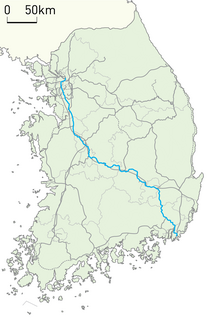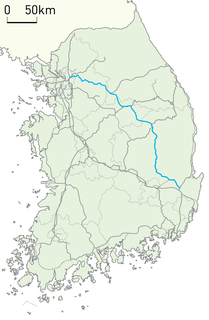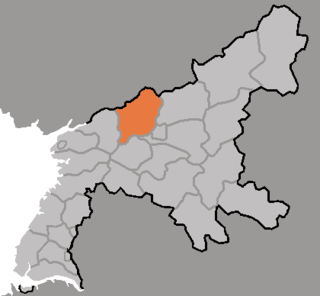
The Gyeongbu Line (Gyeongbuseon) is the most important railway line in South Korea and one of the oldest ones in the country. Gyeongbu line was constructed in 1905, connecting Seoul with Busan, via Suwon, Daejeon, and Daegu. The Gyeongbu Line is by far the most heavily travelled rail line in South Korea.

The Gyeongin Line (Gyeonginseon) is a railway mainline in South Korea, currently connecting Guro Station in Seoul and Incheon. Commuter services along the line through operates into Seoul Subway Line 1.

The East Coast Railway is one of the 17 railway zones of Indian Railways. It came into existence on 1 April 2003. As the name suggests, most of the railway routes of the zone are near the east coast of India. The headquarters of the zone are at Bhubaneswar.

The Jungang line is a railway line connecting Cheongnyangni in Seoul to Gyeongju in South Korea, traversing central South Korea from the northwest to the southeast. It also referred to the rail line of the Seoul Metropolitan Subway from Yongsan station to Yongmun station.

The Gyeongwon Line is a railway line serving northeastern Gyeonggi Province in South Korea. The line is operated by Korail. The name of the line came from Gyeongseong (Seoul) and Wonsan, the original terminus of the line, in what is now North Korea.

The Janghang Line is a railway line serving South Chungcheong Province in South Korea. The line connects Cheonan to the railway junction city of Iksan. The Janghang Line is served by frequent Saemaul-ho and Mugunghwa-ho passenger train services between Seoul and Iksan. There is also a link from Asan Station to the KTX network at Cheonan Asan Station.
25 kV alternating current electrification is commonly used in railway electrification systems worldwide, especially for high-speed rail.

The rail transportation system in South Korea includes mainline railway lines and rapid transit system in some major cities.

The P'yŏngbuk Line is an electrified standard-gauge secondary trunk line of the Korean State Railway in North Pyŏngan Province, North Korea, running from Chŏngju on the P'yŏngŭi Line to Ch'ŏngsu; it meets the Ch'ŏngnyŏn P'arwŏn Line at Kusŏng, and at Ch'ŏngsu, via a bridge across the Yalu River, it goes to Shanghekou, China, where it connects to China Railway's Fengshang Railway to Fenghuangcheng.

The Paech'ŏn Line is a partially electrified standard-gauge secondary railway line of the Korean State Railway in South Hwanghae Province, North Korea, running from Changbang on the Hwanghae Ch'ŏngnyŏn Line to Ŭnbit.

The Sinhŭng Line is an electrified 762 mm narrow gauge railway line of the Korean State Railway in South Hamgyŏng Province, North Korea, running from Hamhŭng (Hamhŭng-si) to Pujŏnhoban (Pujŏn-gun) on Lake Pujŏn via Sinhŭng (Sinhŭng-gun).

The Hŏch'ŏn Line is a partially electrified standard-gauge secondary line of the Korean State Railway running from Tanch'ŏn on the P'yŏngra Line to Honggun.

The Kangwŏn Line is a 145.8 km (90.6 mi) electrified standard-gauge trunk line of the Korean State Railway of North Korea, connecting Kowŏn on the P'yŏngra Line to P'yŏnggang, providing an east–west connection between the P'yŏngra and Ch'ŏngnyŏn Ich'ŏn lines.

The Kŭmgangsan Ch'ŏngnyŏn Line is an electrified standard-gauge trunk line of the Korean State Railway in North Korea running from Anbyŏn to Kamho. The total length of the line is 114.8 km (71.3 mi), but it is only in regular use as far as Kŭmgangsan Ch'ŏngnyŏn; the length of the line to there is 101 km (63 mi).
The Korean State Railway (Kukch'ŏl) operates a wide variety of electric, diesel and steam locomotives, along with a variety of electric multiple unit passenger trains. Kukch'ŏl's motive power has been obtained from various sources. Much, mostly steam and Japanese-made electric locomotives, was inherited from the Chosen Government Railway, the South Manchuria Railway (Mantetsu) and various privately owned railways of the colonial era. Many steam locomotives were supplied by various communist countries in the 1950s, including the Soviet Union, Czechoslovakia, Hungary, Poland, Romania, and China.

The Toshiba DeRoI-class was a group of nine boxcab-style electric locomotives with regenerative braking and the capability for multiple-unit control manufactured by built by Toshiba in 1943-44. They were very similar to the Mitsubishi-built DeRoI-class locomotives and the DeRoNi-class locomotives built by Hitachi. They were built for the Chosen Government Railway (Sentetsu), and after the partition of Korea were inherited by the North Korean State Railway, where they were known as the Chŏngiha class.

The DeRoNi-class was a group of four boxcab-style electric locomotives with regenerative braking and the capability for multiple-unit control manufactured by Hitachi in 1943-44, very similar to the Toshiba-built DeRoI and the Mitsubishi-built DeRoI-class locomotives.

The Mitsubishi DeRoI-class was a group of three boxcab-style electric locomotives with regenerative braking and the capability for multiple-unit control manufactured by Mitsubishi in 1946. They were very similar to the Toshiba-built DeRoI-class locomotives and the DeRoNi-class locomotives built by Hitachi. They were built for the Chosen Government Railway (Sentetsu), but the war ended before delivery took place. They were delivered to the Korean National Railroad after the partition of Korea, which designated them 데로3 ("Dero3"). During the Korean War all were captured by the Korean Peoples Army and taken to North Korea, where they were put into service by the Korean State Railway as the Chŏngisŏ class.
Ch'ŏndong Station is a railway station in Ryongjin-dong, Kaech'ŏn municipal city, South P'yŏngan province, North Korea on the Manp'o Line of the Korean State Railway; it is also the starting point of the Taegak Branch to Taegak.


















